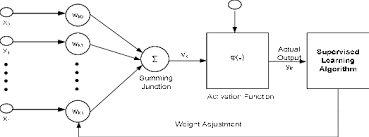Understanding Supervised Neural Networks
In the realm of artificial intelligence and machine learning, neural networks play a pivotal role in solving complex problems. Among various types of neural networks, supervised neural networks are particularly significant due to their structured approach to learning from labeled data. This article delves into the fundamentals of supervised neural networks, their architecture, and their applications.
What is a Supervised Neural Network?
A supervised neural network is a type of artificial neural network that is trained using labeled data. In this context, “supervised” refers to the presence of a supervisor or teacher that provides the correct output for each input during the training process. The goal is for the network to learn the mapping between inputs and outputs so it can make accurate predictions on new, unseen data.
Architecture of Supervised Neural Networks
The architecture of a supervised neural network typically consists of three main layers:
- Input Layer: This layer receives the input data and passes it on to subsequent layers. The number of neurons in this layer corresponds to the number of features in the input data.
- Hidden Layers: These layers perform intermediate computations and feature extraction. A network can have multiple hidden layers with varying numbers of neurons. Each neuron applies an activation function to its inputs to introduce non-linearity into the model.
- Output Layer: This layer produces the final output or prediction. The number of neurons in this layer depends on the nature of the task—one neuron for binary classification, multiple neurons for multi-class classification, or continuous values for regression tasks.
Training Process
The training process involves adjusting the weights and biases within the network to minimize prediction errors. This is achieved through an iterative process called backpropagation combined with an optimization algorithm such as gradient descent. Here’s a brief overview:
- Forward Pass: Input data is fed through the network, and predictions are generated at the output layer.
- Error Calculation:
- Backpropagation:
Applications
Supervised neural networks have wide-ranging applications across various domains due to their ability to learn complex patterns from labeled data:
- Image Recognition: Used in facial recognition systems, medical imaging diagnostics, and autonomous vehicles.
- < strong >Natural Language Processing (NLP): Applied in sentiment analysis, machine translation, chatbots, and speech recognition.
- < strong >Financial Forecasting: Utilized for stock price prediction, credit scoring models, fraud detection.
- < strong >Healthcare: Employed in predicting disease outcomes from patient records or medical images.
Conclusion
Supervised neural networks are powerful tools that have revolutionized many industries by enabling machines to learn from labeled datasets effectively. Their structured learning approach allows them to make accurate predictions across diverse applications—from recognizing images accurately identifying sentiments within text data understanding how these systems work opens up endless possibilities harnessing potential artificial intelligence solving real-world challenges.
Understanding Supervised Neural Networks: Key Questions Answered
- What is the difference between supervised and unsupervised neural networks?
- What is a supervised neural network?
- Is ANN supervised or unsupervised?
- What is the difference between supervised and unsupervised neural network?
- Is neural network a supervised algorithm?
- Which neural network uses supervised learning?
- Is CNN supervised or unsupervised learning?
What is the difference between supervised and unsupervised neural networks?
One frequently asked question in the field of neural networks is about the difference between supervised and unsupervised neural networks. In supervised neural networks, the model is trained using labeled data, where each input is associated with a corresponding output. The network learns to map inputs to outputs based on the provided labels, making it suitable for tasks like classification and regression. On the other hand, unsupervised neural networks operate without labeled data and focus on finding patterns or structure within the input data. These networks are used for tasks such as clustering, dimensionality reduction, and anomaly detection, where the goal is to uncover hidden relationships or groupings in the data without explicit guidance. Understanding the distinction between supervised and unsupervised neural networks is essential for choosing the right approach based on the nature of the problem at hand.
What is a supervised neural network?
A supervised neural network is a type of artificial neural network that relies on labeled data for training. In the context of machine learning, the term “supervised” indicates that the network learns from examples where both input data and corresponding output labels are provided. By analyzing and processing this labeled data during the training phase, a supervised neural network can learn to make predictions or classifications on new, unseen data with a high degree of accuracy. This structured learning approach distinguishes supervised neural networks from other types of neural networks and underpins their effectiveness in various applications across different domains.
Is ANN supervised or unsupervised?
Artificial Neural Networks (ANN) can be categorized into different types based on the learning approach they employ. When it comes to the question of whether ANN is supervised or unsupervised, it is important to clarify that ANN can be either supervised or unsupervised, depending on the specific task at hand. In a supervised neural network, the model learns from labeled training data, where each input is associated with a corresponding output or target. On the other hand, in an unsupervised neural network, the model learns patterns and relationships from unlabeled data without explicit guidance on what the output should be. Therefore, the distinction between supervised and unsupervised neural networks lies in how they learn and process data to achieve their respective objectives.
What is the difference between supervised and unsupervised neural network?
One frequently asked question in the realm of neural networks is: “What is the difference between supervised and unsupervised neural networks?” The key distinction lies in the type of learning each network employs. In supervised neural networks, the model is trained on labeled data, where each input is associated with a corresponding output. The network learns to map inputs to outputs based on these labels. On the other hand, unsupervised neural networks operate without labeled data; instead, they aim to find patterns and relationships within the input data itself. Unsupervised networks are used for tasks such as clustering, dimensionality reduction, and anomaly detection, where the model must identify underlying structures without explicit guidance from labeled examples. Understanding this difference is crucial for selecting the appropriate type of neural network based on the nature of the task at hand.
Is neural network a supervised algorithm?
The question “Is a neural network a supervised algorithm?” often arises in discussions about machine learning. It’s important to clarify that a neural network itself is not inherently supervised or unsupervised; rather, it is a type of model that can be used in both supervised and unsupervised learning scenarios. In the context of supervised learning, a neural network is trained using labeled data where the correct outputs are provided during training. This allows the network to learn the relationship between inputs and outputs. On the other hand, in unsupervised learning, neural networks are used to find patterns and structures in unlabeled data without explicit guidance on the correct output. Therefore, while neural networks can be employed in supervised learning tasks, they are not exclusively tied to this type of algorithmic approach.
Which neural network uses supervised learning?
In the realm of artificial intelligence and machine learning, the neural network that predominantly utilizes supervised learning is known as a supervised neural network. In this type of network, a supervisor or teacher provides labeled data during the training process, enabling the network to learn the mapping between inputs and outputs. By leveraging this structured approach to learning, supervised neural networks can make accurate predictions on new, unseen data by understanding patterns and relationships within the labeled dataset. This methodology is widely employed in various applications such as image recognition, natural language processing, financial forecasting, and healthcare analytics, showcasing the versatility and effectiveness of supervised learning in training neural networks.
Is CNN supervised or unsupervised learning?
The frequently asked question regarding Convolutional Neural Networks (CNNs) often revolves around whether CNN is a form of supervised or unsupervised learning. It is important to clarify that CNN is primarily a supervised learning technique. In supervised learning, the network is trained on labeled data, where input data and corresponding output labels are provided during the training process. CNNs are specifically designed to learn and extract features from input data through multiple layers of convolutions and pooling, ultimately making predictions based on the labeled data it has been trained on. This structured approach distinguishes CNN as a powerful tool in tasks such as image recognition and classification, where the network learns to map inputs to specific outputs with high accuracy.



